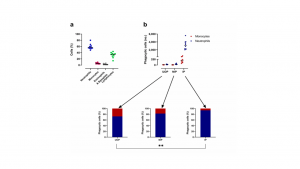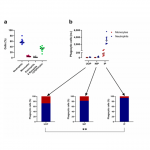Malaria manifests and develops its clinical phenotype following blood-stage Plasmodium falciparum infection. Intraerythrocytic replication of asexual parasites and release of free merozoites (offspring parasites) into circulation further characterises this infection which leads to invasion new erythrocytes. Free merozoites may be an interesting target for therapeutics due to the fact that they have an increased vulnerability to various defence mechanisms/factors of the host including: immune factors, including antibodies, complement, and leukocytes.
It is known that passive transfer of IgG antibodies from individuals with naturally acquired immunity (NAI) against malaria to Plasmodium falciparum-infected patients could control parasiteamia and alleviate fever. IgG antibodies specifically targeting malaria may aid in protection of the host by directly preventing merozoite invasion of erythrocytes or may aid immune effector cells through cell-surface Fc gamma receptors (FcγR). Upon engagement, FcγRs trigger potent immune cell mechanisms which lead to parasite killing. One of these mechanisms include the opsonic phagocytosis (OP) which has been reported as a consistent and effective protection mechanism against malaria in sero-epidemiological studies and has been associated with overall protection against malaria. However, previous studies investigating this mechanism have mostly relied on the use of defined cell types and may not be representative of the peripheral blood environment. The role of the different peripheral blood phagocytes in OP of blood-stage P. falciparum merozoites and their overall contribution to blood-stage malaria immunity is yet to be described using such unbiased in vitro bioassays…until now.
Garcia-Sensiain, et al., have developed an in vitro OP assay using peripheral blood leukocytes (PBL) that has allowed for the elucidation and quantification of the contribution of each phagocytic cell type in the OP of merozoites. Through the use of a physiologically relevant in vitro phagocytosis assay, which included all PBL (relative to their normal composition in peripheral blood), they investigated the role of different cell types and their respective FcγRs in IgG-mediated phagocytosis of blood-stage P. falciparum merozoites. They successfully demonstrated that both the human neutrophils and monocytes were highly active in the phagocytosis of extracellular merozoites. In this study they reported a dominant phagocytic cell type of CD14+ +CD16– monocytes at very low antibody levels and FcγRIIA has a key role. They reported that higher levels of antibody deposition on merozoites (indicated by higher IFA titers), stimulated neutrophils subsequently leading to their dominant phagocytic role, while lower levels of antibody deposition on merozoites (indicated by lower IFA titers), monocytes still maintained a dominant phagocytic role. As not to be confused, they concluded here that neutrophils are the main phagocytes of antibody-opsonized merozoites in peripheral blood while classical monocytes dominate the monocytic contribution due to their relatively higher numbers although not being the most efficient phagocytes on per cell basis. In addition, neutrophils are short-lived frontline responders with high phagocytic activity whilst the opposite can be said true for monocytes.
Despite the antibody type i.e., nonimmune plasma (NIP) and immune plasma (IP), used to opsonize merozoites, both the neutrophils and monocytes were active in the phagocytosis of merozoites, whereby neutrophils were more active (Fig. 1b). As neutrophils are the most abundant (50-70%) leukocytes in human blood-forming the first line of defence following an infection (Fig. 1a), this result was to be expected.
“Neutrophils possess a range of antimicrobial effector functions like respiratory burst activity, which releases reactive oxygen species (ROS). ROS are highly toxic to intraerythrocytic malaria parasite development and neutrophil-mediated antibody-dependent respiratory burst (ADRB) is associated with protection against clinical malaria.”
 Fig 1: Malarial antibodies induce merozoite-phagocytosis by neutrophils and monocytes. (A) Percentage of individual leukocytes in PBLs from Danish blood donors (n = 10) was enumerated by flow cytometry. Horizontal lines represent median values. (B) From each donor, 6 × 104 PBLs were incubated with unopsonized merozoites (UOP), merozoites opsonized with a pool of nonimmune plasma (NIP), or with immune plasma (IP) for 30 min at 37 °C for phagocytosis to occur. Cells were stained with anti-CD14, CD16, CD45, and CD66b antibodies and analyzed by flow cytometry to enumerate ethidium bromide (EtBr)-positive cells. The mean number (no.) of neutrophils (blue) and monocytes (red), which ingested merozoites are shown in the upper panel, and the percent contribution of neutrophils and monocytes to overall PBL phagocytosis is shown in lower panels for the given opsonized/unopsonized condition. Results were obtained with PBLs from 10 different Danish blood donors (a–c). P values were determined by Wilcoxon signed-rank test(B). Asterisks represent P values (**P < 0.01) (Garcia-Senosiain, et al.,2021).
Fig 1: Malarial antibodies induce merozoite-phagocytosis by neutrophils and monocytes. (A) Percentage of individual leukocytes in PBLs from Danish blood donors (n = 10) was enumerated by flow cytometry. Horizontal lines represent median values. (B) From each donor, 6 × 104 PBLs were incubated with unopsonized merozoites (UOP), merozoites opsonized with a pool of nonimmune plasma (NIP), or with immune plasma (IP) for 30 min at 37 °C for phagocytosis to occur. Cells were stained with anti-CD14, CD16, CD45, and CD66b antibodies and analyzed by flow cytometry to enumerate ethidium bromide (EtBr)-positive cells. The mean number (no.) of neutrophils (blue) and monocytes (red), which ingested merozoites are shown in the upper panel, and the percent contribution of neutrophils and monocytes to overall PBL phagocytosis is shown in lower panels for the given opsonized/unopsonized condition. Results were obtained with PBLs from 10 different Danish blood donors (a–c). P values were determined by Wilcoxon signed-rank test(B). Asterisks represent P values (**P < 0.01) (Garcia-Senosiain, et al.,2021).
Interestingly, they further hypothesized that differences in FcγR density, as well as specificity and affinity toward IgG subclasses may determine the degree of merozoite-phagocytosis by neutrophils and monocytes, respectively. They showed that antibody-mediated phagocytosis of blood-stage P. falciparum by neutrophils is also involved in NAI. Using the phagocytosis assay they were also able to demonstrate the association between IgG-mediated OP of blood-stage P. falciparum merozoites while elucidating the mechanisms of protection against febrile malaria in two different cohorts, Ghana and India (longitudinal studies). Within the Ghanaian cohort, they reported that the phagocytosis promoting activity of monocytes was significantly linked with a reduced risk of febrile malaria.
The study by Garcia-Senosiain, et al., has identified both cell types i.e., the monocytes and neutrophils, as two important peripheral blood leukocytes, where the two possess different physiological properties, both contributing to IgG-mediated phagocytosis of malaria parasites. This is important for immunity against malaria. OP of blood-stage merozoites by both cell types seem to work in conjunction, subsequently complementing each other in the development of protective immunity against malaria.
The authors summary: “Our study shows that neutrophils contribute significantly to IgG-mediated phagocytosis of blood-stage P. falciparum merozoites and protection against febrile malaria. These findings further elucidate neutrophil antibody-mediated immune mechanisms against blood-stage malaria parasites.”
Journal Article: Garcia-Senosiain et al., 2021. Neutrophils dominate in opsonic phagocytosis of P. falciparum blood-stage merozoites and protect against febrile malaria. Nature Communications Biology.
Summary by Stefan Botha
